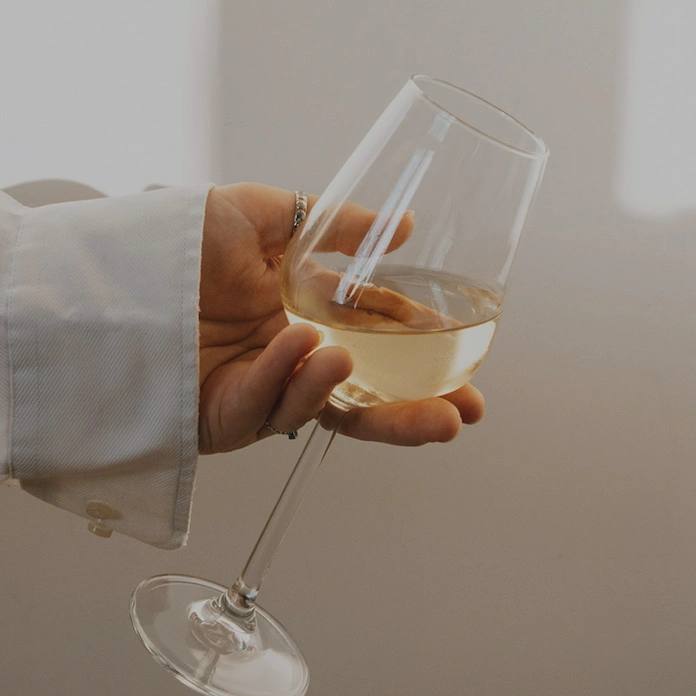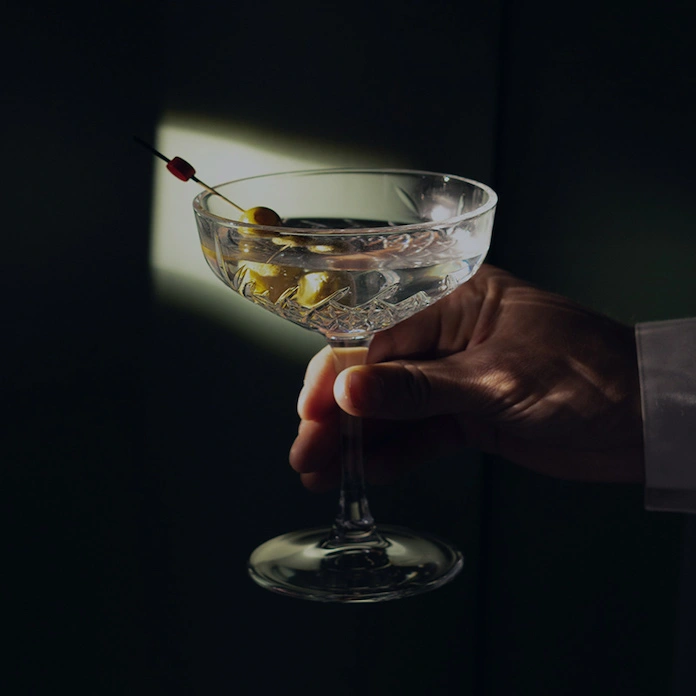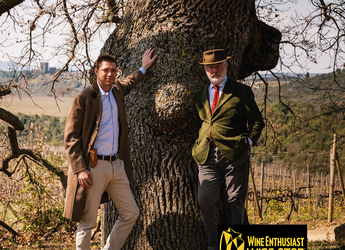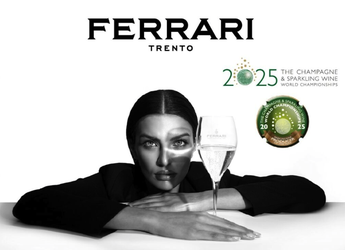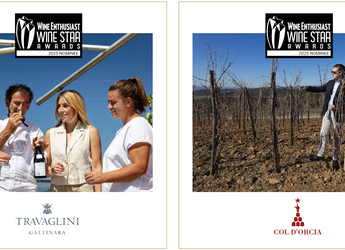
The Rocca delle Macìe Story From Silver Screen to Top of the Tuscan Scene

The story of Rocca delle Macìe begins not in the vineyard, but on a soundstage in Rome.
Film producer Italo Zingarelli made his name with spaghetti westerns, most notably “The Trinity Series,” starring Bud Spencer and Terrence Hill. Emboldened by his success, Italo decided to pursue his lifelong dream of making wine by founding Rocca delle Macìe in 1973.
From a small, family-run business in the village of Castellina, Rocca delle Macìe has become one of Tuscany’s most renowned wine producers. Led today by Sergio Zingarelli, Italo’s youngest son, Rocca delle Macìe consists of six estates. The original Le Macìe, along with their Tenuta Sant’Alfonso, Riserva di Fizzano, and Le Tavolelle lie in Castellina, in the Chianti Classico region. The Zingarellis’ two other properties, Campo Maccione and Casamaria, are in the coastal region of Maremma.
Since taking up the reins from his father, Sergio has launched several quality-focused changes, including introducing single-vineyard Chianti Classicos, limiting production, and shifting to a more elegant style of winemaking. Hand-in-hand with this laser-focus on quality, he is also dedicated to preserving the land, implementing sustainable viticulture practices across their 206 hectares/508 acres of vineyards. These measures range from the use of organic fertilizers and preventing soil erosion to introducing bees to encourage biodiversity. Not only have these efforts led to Rocca delle Macìe being awarded the VIVA Certification for Sustainability in Viticulture from the Italian government, but the family’s mindful approach also ensures the health of the growers who hand-tend the vines. To Sergio, these men and woman are an important part of the family.
That same level of care extends into the cellars, which Sergio has modernized with state-of-the-art equipment and fine Slavonian and French oak barrels. While the Rocca delle Macìe winery team primarily crafts Chianti Classico DOCG wines, they also make Super Tuscans from grapes grown at the Chianti Classico properties, along with red, white, and rosé Maremma DOC wines. No matter the designation, all Rocca delle Macìe’s wines marry modern vibrancy with classic Tuscan elegance.
It's a rare success story. Given the ample competition, few producers manage to rise through the ranks of the Tuscan wine scene. But with Rocca delle Macìe, a star has been born — and it will only continue to shoot to new heights.
Rocca delle Macìe Highlights
Film producer Italo Zingarelli founded Rocca delle Macìe in 1973, fulfilling his lifelong dream of making wine.
The business remains a family affair, led today by Sergio, Italo’s son and a former two-time President of the Chianti Classico Consortium.
Rocca delle Macìe consists of six Tuscan estates — four in Chianti Classico and two in Maremma.
Sustainable viticulture practices and careful vine management ensure only the best grapes make it into the wines.
Major industry acclaim includes multiple 90+ point scores from Wine Spectator, Wine Enthusiast, The Wine Advocate, and critic James Suckling.

-
Founded
1973 -
Location
Castellina, Tuscany, Italy -
Follow On
On Location in Chianti Classico
With its rolling hills, cypress-lined roads, and quaint villas, Tuscany’s wine country looks like something out of a movie — indeed, it has provided the location for many popular films. While the scenery undoubtedly attracted Italo Zingarelli to the region, he cared more about its reputation for producing world-class wines. After months of searching in both Tuscany and Piedmont (northern Italy’s fine wine capital), he discovered Le Macìe, a medieval farming hamlet near the village of Castellina in southern Chianti Classico, an area home to some of Tuscany’s best wines. He founded the Rocca delle Macìe winery here, and the property remains the heart of the family business to this day.
From the Hills of the Chianti Classico DOCG to the Maremma Coast
To craft the best-quality estate-grown wines, the Zingarelli family has sought out properties in two of Tuscany’s top regions. Four estates lie in Castellina, one of Chianti Classico’s original districts, and grow sangiovese (the region’s signature red grape variety), cabernet sauvignon, merlot, and colorino. The area benefits from a warm Mediterranean climate that gives these varieties ample time to ripen. Chianti Classico’s hilly landscape allows vineyards to grow at higher altitudes (up to nearly 610 meters/2,000 feet along Castellina’s ridge), providing grapes with the sun exposure to develop concentrated flavors and cool nights that preserve their vibrancy.
Rocca delle Macìe’s other two estates lie in Maremma, which extends from the Tyrrhenian coast to the Apennine foothills. Here, the family has planted sangiovese, cabernet sauvignon, merlot, syrah, chardonnay, and vermentino (Tuscany’s great white grape variety). Like Chianti Classico, it has a warm Mediterranean climate but is cooled by sea breezes that help the grapes retain freshness. The predominantly clay soils yield grapes with greater complexity.

An Individualized Approach to Sustainable Viticulture
The Zingarelli family’s deep respect for the Firenze wine region, which they are proud to call home, has inspired their sustainability efforts. They take sustainability so seriously, they’ve performed microzoning on all of Rocca delle Macìe’s vineyards, so they can attend to the specific needs of each individual site.
Their sustainable viticulture practices include the exclusive use of organic fertilizers and green manure, mechanical weeding (meaning no chemical herbicides), and the prevention of soil erosion through dry stone walls, terraces, and drainage systems. They’ve also introduced bees into their vineyards to conserve Tuscany’s natural biodiversity and have installed alarm systems to monitor vine health and the presence of damaging insects, which they remove by bringing in antagonistic insects (as opposed to spraying harmful pesticides). For these efforts, and many more, Rocca delle Macìe has received the VIVA Certification for Sustainability in Viticulture from the Italian Ministry of the Environment.

Painstakingly Handcrafted from Vine to Barrel
As the Rocca delle Macìe winery team proudly tell us, “The successes we have achieved as a winery are based, first and foremost, on the painstaking approach we take in the vineyards.” The team performs leaf removal and green harvest to keep yields low and produce greater concentration in the remaining fruit. Then, they harvest the perfectly ripened bunches by hand to ensure only the best-quality grapes go into the wines.
The cellar team’s job is simple — make the most of the vine growers’ hard work. Each of Rocca delle Macìe’s cellars (four in Chianti Classico and one in Maremma) have been expanded and modernized with state-of-the-art fermentation equipment. For wines that require oak aging, the team use top-notch Slavonian and French oak barrels. Oak regimen or no, there is serious care that goes into every bottle and wines are only released when they’ve reached the start of their delicious peak.

Sergio Zingarelli Continues the Family Tradition
Following in his father’s footsteps, Sergio Zingarelli took over leadership of Rocca delle Macìe in 1985. With the collaboration of his wife, Daniela, who works on the administrative side of the family business, Sergio has overseen several important milestones for the winery. They have developed Rocca delle Macìe’s international distribution network, managed the acquisition of three of the company’s estates, and implemented their all-important sustainability measures. A true ambassador for the Chianti Classico DOCG, Sergio has also held several positions within the Chianti Classico Consortium, including two terms as President, the maximum number of times one can serve in that position.
His most significant role? Sergio has imparted his love of wine to his two children, Andrea and Giulia, who have joined the family business. Andrea focuses on distribution, while Giulia works in sales and in hospitality at the Riserva di Fizzano. They will be the third generation to share Rocca delle Macìe’s fine, estate-grown wines with the world.





